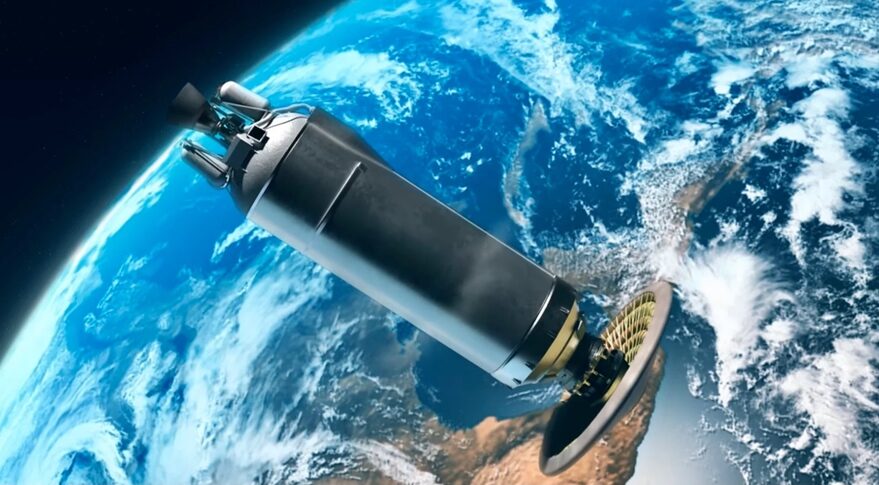WASHINGTON — A payload hitching a ride on the launch of a weather satellite will demonstrate a technology that both NASA is considering for future Mars landings and a company is studying for rocket reusability.
A United Launch Alliance Atlas 5 is scheduled to lift off from Vandenberg Space Force Base in California at 4:25 a.m. Eastern Nov. 10. The primary payload of the rocket is the Joint Polar Satellite System (JPSS) 2 weather satellite, which will be placed in a polar orbit to collect weather data for the National Oceanic and Atmospheric Administration. The launch was previously scheduled for Nov. 1 but postponed to replace a battery in the rocket’s Centaur upper stage.
A secondary payload on the launch of JPSS-2 is Low-Earth Orbit Flight Test of an Inflatable Decelerator (LOFTID), a NASA technology demonstration. While JPSS-2 will be deployed nearly a half-hour after liftoff, LOFTID will remain attached to the Centaur until 75 minutes after liftoff, following a deorbit burn of the Centaur.
Shortly before deployment, LOFTID will inflate a reentry shield six meters in diameter. That heat shield will slow down the vehicle from orbital velocity to Mach 0.7 as instruments on board collect data on the performance of the shield. LOFTID will then deploy parachutes to slow it down for the rest of its descent, splashing down in the Pacific east of Hawaii to be recovered by a ship.
LOFTID is the latest in a series of technology demonstrations by NASA of inflatable reentry systems whose size is not constrained by the payload fairing of the rocket. “Currently, using rigid technologies, we’re limiting the size of the aeroshell itself to fit within the fairing of a launch vehicle,” or no more than about five meters across, said Joe Del Corso, LOFTID project manager at NASA’s Langley Research Center, during a pre-launch briefing in October. That limits the size of payloads delivered to the surface of Mars to about 1.5 metric tons.
A larger aeroshell, using inflatable technology, could enable much heavier payloads, up to the range of 20 to 40 metric tons. “It’s what you need to put humans on Mars,” he said. Larger aeroshells also enable access to higher terrains on Mars where the atmosphere is not dense enough to slow down vehicles with existing systems.
NASA hopes to collect performance on inflatable heat shields with the LOFTID test. John DiNonno, LOFTID chief engineer at NASA Langley, said the heat shield will see peak temperatures in excess of 1,400 degrees Celsius during reentry and experience decelerations of up to 9g. The inflatable structure is protected by a flexible thermal protection system made of materials that can be tailored for the specific mission.
A ship off the coast of Hawaii will recover LOFTID after splashdown, but as a precaution the vehicle will eject data recorders while descending under parachutes that can be recovered separately. It will also return some limited data in real time. “We should be able to get some preliminary feedback within at least a couple hours of reentry on whether it was successful or not,” Del Corso said.
LOFTID cost NASA nearly $93 million over five years, said Trudy Kortes, director of technology demonstrations in NASA’s Space Technology Mission Directorate. NASA is also cooperating with ULA on the mission through an unfunded Space Act Agreement, with ULA supporting integration of LOFTID on the Centaur, as well as the parachute system and recovery ship. The LOFTID mission is formally dedicated to Bernard Kutter, a ULA engineer who worked on advanced technologies but died unexpectedly in 2020.
John Reed, ULA’s chief technologist, said his company is interested in LOFTID as part of the company’s Sensible Modular Autonomous Return Technology (SMART) reusability concept for its Vulcan rocket. Under the SMART approach, the engine section of the Vulcan booster would detach after stage separation and deploy an inflatable aeroshell to slow it during reentry. A parachute would slow the engine section in the final phases of descent.
He said the company is also interested in broader commercial applications of the technology. “The whole focus of this effort has been to develop a path that can support not just us but also LEO commercial applications, returning products from cislunar, as well as getting on to Mars and having the downmass to really enable humanity’s expansion.”
Those future applications will require much larger aeroshells than the six-meter version being tested on LOFTID. At a briefing during the AIAA ASCEND conference Oct. 25, Michelle Munk, acting chief architect at NASA’s Space Technology Mission Directorate, estimated ULA will likely need aeroshells 12 to 14 meters across, while Mars landers may need versions up to 16 meters across.
“We have in our development strategy scaled-up flight tests,” she said, which would also make the inflatable aeroshells more robust and include integrated guidance, navigation and control required for Mars missions.
She added that she expected that any ULA testing of larger inflatable decelerators would support NASA Mars plans. “We’ll get several flights of the hypersonic inflatable aerodynamic decelerator that will be instrumented and give us increased data sets about its performance in the flight environment, which we can use to build confidence and make improvements,” she said.
Those future tests by ULA, she said, will also help sustain vendors that produce key components of inflatable aeroshells that NASA will rely on for future missions. “We see this as a wonderful partnership and a way to maintain the supply chain and keep the learning going as we progress, in the long term, towards a Mars mission.”
Kortes said it’s too early to determine when an inflatable decelerator might be used on a Mars mission. “This is risk reduction,” she said. After LOFTID, “there is a scale-up that we would begin to talk about, begin to work on.”

